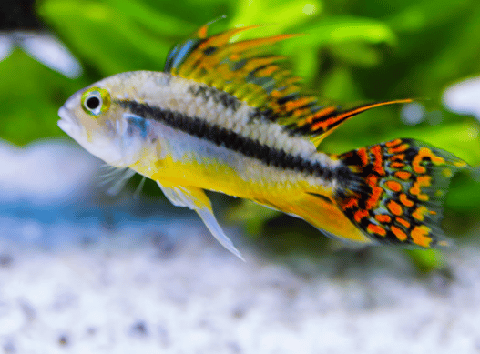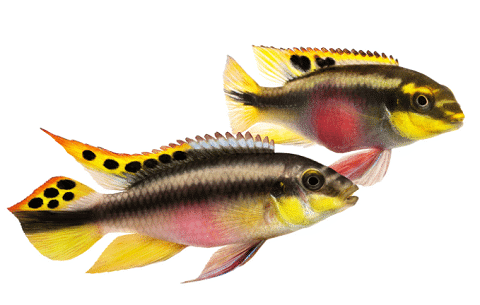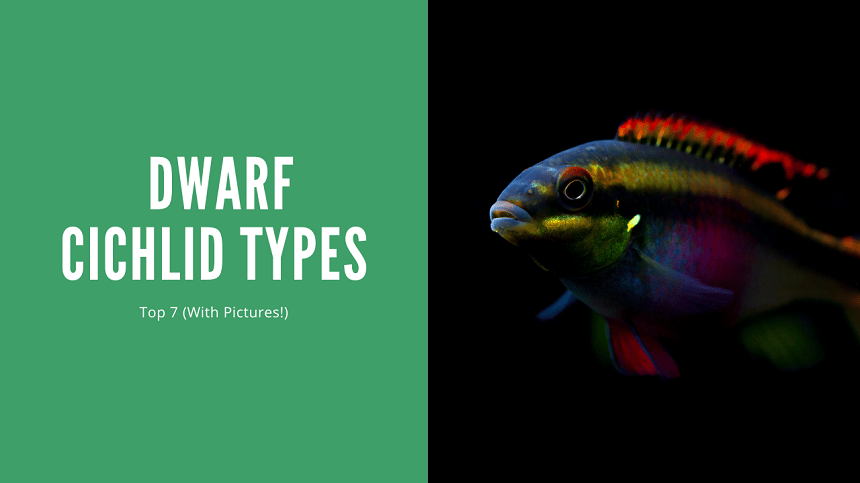Thank you for visiting! By the way… any links on this page that lead to products on Amazon and other stores/partners are affiliate links Aquarium Store Depot earns a commission if you make a purchase.
Dwarf cichlids are a popular fish kept by many fish enthusiasts. They are colorful, small, and thrive in community tanks. There are many different types of dwarf cichlids, each with its own personality and requirements. In this blog post, we will cover the top 7 dwarf cichlid types and provide pictures for each one. We hope you find this information helpful!
Introduction to Dwarf Cichlids
Large cichlid tanks can look incredible, featuring bold and colorful hand-designed species of African and South American cichlids. However, many of these species are notorious for displaying aggressive behavior and require their own cichlid-specific setups.
What if you could have all the beauty and personality of a cichlid while also having a community tank? A dwarf cichlid species could be exactly what you’re looking for.
Dwarf cichlids are extremely popular in the aquarium hobby for several reasons. One, they stay manageable sizes. This opens them up to many hobbyists looking to only keep a nano tank instead of a hundred-gallon display. These fish are also just as colorful as larger cichlids, but are much more peaceful and forgiving of other fish in the aquarium.
Lastly, dwarf cichlids are some of the easiest and most rewarding fish to breed in the aquarium. Dwarf cichlids display parenting behaviors that are not seen in other species, making them an exciting challenge for eager aquarists.
What Is a Dwarf Cichlid?
Cichlids are easy to define; they are any fish that belongs to the Cichlidae family. Defining a dwarf cichlid is much more difficult.
Dwarf cichlids do not belong to a certain scientific group. The name has been coined by the aquarium trade to loosely describe members of the Cichlidae family that stay under about 4-5 inches.
Though there are no specific species of dwarf cichlid, most of the preferred species originate from the rain forests of South America. This includes members of the Mikrogeophagus, Apistogramma, Aequidens, and Heros genera. A few species of African dwarf cichlid also fall under this category, like west African dwarf cichlids (Nanochromis transvestitus) and kribensis (Pelvicachromis pulcher).
How Big Do Tjeu get?
Hobbyists generally agree that any cichlid that falls under 5 inches is considered a dwarf species. Anything over this is a regular-sized cichlid species.
Species
What makes dwarf cichlids so popular? Not only are they extremely colorful and mostly peaceful, but they’re pretty easy to keep if you have some prior knowledge of fishkeeping.
With so many different species to choose from, it can be difficult to get started though.
Are They Hard to Keep?
Cichlids aren’t the easiest fish to keep, but they thrive with stability. Like any other group of fish, some dwarf cichlid varieties are more difficult to keep than others, demanding more perfect water conditions or a specific diet.
For the most part, all dwarf cichlids have similar tank setups and considerations that are easy to maintain once conditions have been initially met.
What is the easiest cichlid to keep?
Believe it or not, you may have already kept a type of cichlid without even knowing it. Freshwater angelfish (Pterophyllum scalare) are some of the most commonly sold cichlids even though they’re usually not labeled as such.
In terms of ‘real’ dwarf cichlids though, most species you come across will be easy to care for. Many hobbyists recommend kribensis or a species of Apistogramma for a first-time addition.
What is the Most Peaceful?
In general, most dwarf cichlids are peaceful species. The key to keeping dwarf cichlids happy is giving them the right tank conditions and tank mates so that they never feel threatened or stressed. That being said, some species can still display incredibly aggressive and territorial behavior during spawning periods.
Tank Setup
Each fish species will have its own preferred tank setup, water conditions, and diet though the general foundation of the aquarium is usually the same.
Most dwarf cichlids require at least a 10-gallon tank with pairs needing upwards of 20 gallons. They originate from calm waters with dense vegetation and a sandy substrate. Dwarf cichlids can be messy eaters, so a powerful filter with a slow return is needed.
The bottom can be covered with leaf litter and other detritus. Plenty of caves and hiding places in the shape of driftwood, rocks, and terra cotta pots may also be added for territory and spawning purposes. Be warned that any aquatic plants and decorations added to the aquarium may be dug up and moved based on the preferences of your fish.
Dwarf cichlids also appreciate dimmed lighting. This can become problematic if keeping more light-demanding plant species. A simple solution may be adding floating plants or aquascaping the aquarium in a way for designated background, midground, and foreground species.
What is the Smallest Tank for this Type?
The smallest tank for a dwarf cichlid is 10 gallons. Once established, these fish won’t swim around the tank much, but they need space to move comfortably.
A 10 gallon aquarium is enough for a single cichlid with minimal tank mates. A longer 20 gallon tank is more optimal for a pair and additional tank mates.
Tank Mates
The best community tank mates for dwarf cichlids are each other in a species-only tank. A bonded pair of dwarf cichlids that spawns regularly can be one of the most exciting and rewarding tanks that a fishkeeper has. However, some hobbyists want to create a natural ecosystem in their cichlid tanks by introducing tank mates.
Luckily, most species of dwarf cichlid are peaceful enough to tolerate some other fish species. Some community tank mate options include:
The key to picking suitable dwarf cichlid tank mates is having species that occupy other sections of the tank. Dwarf cichlids largely stay in the middle and bottom layers of the water column. All other smaller fish should stay at the top or extreme bottom of this range.
It is likely that some fish will be eaten if your dwarf cichlids decide to spawn. Remove them beforehand if you do not want to lose any fish.
Diet
Most dwarf cichlids are accepting of a variety of foods. These fish are largely carnivores and will appreciate an array of live, frozen, and freeze-dried foods like brine shrimp, worms, and various fresh seafood. Feeding dwarf cichlids a high-quality diet will promote spawning and keep your fish as colorful as possible.
Some species, like kribensis, require a plant-based diet instead. True requirements will vary from species to species. However, dwarf cichlids are generally messy eaters overall so it’s important to remove any uneaten food.
Breeding
Next to their colors and personalities, dwarf cichlids are adorned for their unique breeding behaviors. To get started breeding these beautiful fish, you will need a bonded pair with a densely planted aquarium and available cave systems. Provide a high-quality diet to promote spawning.
Most dwarf cichlids are cave spawners, meaning that they’ll claim structured spawning sites throughout the tank to raise their young. The male will make attempts to court the female fish. If successful, the female will lay eggs on the sides of the cave where the male will then fertilize them.
For the most part, female dwarf cichlids will guard the eggs and raise the fry, though the male may help at times; some species may eat their young after hatching. Provide small foods for the fry to eat and remove them once they’re independent of their parents.
Top 7 Types
Though every cichlid might look different from the next, there are a few species of dwarf cichlid that can be found in aquarium stores; for the most part, this selection won’t be found in some commercial pet stores and will need to be purchased from a more specialized shop.
The video above is from our YouTube Channel. We go over in more detail in our blog post below. If you like our content, be sure to subscribe! Let’s go over some of the most common dwarf cichlids you’re bound to come across at your local fish store!
1. Cockatoo/Apistogramma cacatuoides

- Scientific Name: Apistogramma cacatuoides
- Difficulty Level: Moderate
- Temperament: Semi-aggressive
- Adult Size: 2.5 inches
- Minimum Tank Size: 20 gallons
- Diet: Feed frozen, live, and dried foods
- Origin: South America
- Temperature: 72-86° F
- pH: 6.5-7.5
- Difficulty to breed: Easy
- Planted tank suitability: Yes
The cockatoo dwarf cichlid is readily available and inexpensive. In fact, these Apistogramma fish are near the top of being the most traded species in all of the hobby!
These fish are not the most colorful species of cichlid, but they make up for it with finnage. Both the males and females of this species have very natural green and tan coloration on the body with a black midlateral line. Males are especially impressive to look at as they have long red, fiery fins. Males also grow to be considerably larger than the plainer females.
Male cockatoo cichlids can be aggressive especially during breeding periods, though these fish are generally peaceful. They spawn in cave settings and will defend their nests to the death.
2. Redfin Three-Striped/Apistogramma trifasciata
- Scientific Name: Apistogramma trifasciata
- Difficulty Level: Moderate
- Temperament: Peaceful
- Adult Size: 2.2 inches
- Minimum Tank Size: 20 gallons
- Diet: Feed frozen, live, and dried foods
- Origin: South America
- Temperature: 72-84° F
- pH: 5.0-7.0
- Difficulty to breed: Moderate
- Planted tank suitability: Yes
The redfin three-striped dwarf cichlid (video source) is a much more colorful species of Apistogramma than the cockatoo. Male fish are bright bluish-green with signature black dorsal and midlateral lines; unlike the cockatoo cichlid, redfins have nearly transparent fins with a slight hint of red. In contrast, female redfins may turn completely yellow and are relatively smaller.
These dwarf cichlids can be very aggressive during spawning periods. They are slightly more difficult to breed than cockatoo cichlids due to their aggressive behavior. On top of that, redfins are very prone to aquarium diseases and infections and are especially sensitive to strong medications.
3. Ram Cichlids

- Scientific Name: Mikrogeophagus ramirezi
- Difficulty Level: Moderate-Expert
- Temperament: Peaceful
- Adult Size: 2.5 inches
- Minimum Tank Size: 20 gallons
- Diet: Feed frozen, live, and dried foods
- Origin: South America
- Temperature: 72-79° F
- pH: 5.0-7.5
- Difficulty to breed: Moderate-Expert
- Planted tank suitability: Yes
Arguably the most well-known type of dwarf cichlid, ram cichlids are extremely popular and have been modified to show the best colors possible, such as the electric blue variation (Mikrogeophagus ramirezi “Electric Blue”). These fish may also be labeled as German blue rams or simply as blue rams.
The regular variation of the ram cichlid is still just as colorful, though wild individuals are the most colorful. Male ram cichlids are light blue or yellow in color with a vertical black line that goes over the eye and a black spot in the middle of the body. This coloration travels onto their extended fins, which females lack; females are smaller overall and have shorter bodies.
Due to being bred at such a rapid rate, many of these fish prove to be infertile. A compromised immune system also makes these fish more challenging to keep than some of the other cichlids on this list.
4. Kribensis

- Scientific Name: Pelvicachromis pulcher
- Difficulty Level: Easy
- Temperament: Semi-aggressive
- Adult Size: 4 inches
- Minimum Tank Size: 20 gallons
- Diet: Mainly vegetable-based foods with supplemented frozen, live, and dried foods
- Origin: Western Africa
- Temperature: 72-82° F
- pH: 6.0-8.0
- Difficulty to breed: Easy
- Planted tank suitability: Yes
Easy to keep, the kribensis is a popular introduction to the world of dwarf cichlid fish. However, they’re slightly larger than some of the other nano species on this list, which means that they need the tank size to match.
Though kribensis are native to Western Africa where water is harder and alkaline, these fish are found in softer and more acidic tributaries. This means that their preferred water parameters are almost identical to those commonly found with South American dwarf cichlids.
Kribensis are one of the easiest species of dwarf cichlid to breed. Both males and females are yellowish in color with females being slightly more vivid; they both have dorsal and mid-lateral black stripes with a reddish hue to their bellies.
It should be noted that these fish prefer a more herbivorous diet than most other dwarf cichlids.
5. Panda

- Scientific Name: Apistogramma nijsseni
- Difficulty Level: Moderate
- Temperament: Peaceful
- Adult Size: 3 inches
- Minimum Tank Size: 20 gallons
- Diet: Feed frozen, live, and dried foods
- Origin: South America
- Temperature: 72-84° F
- pH: 5.0-7.0
- Difficulty to breed: Moderate
- Planted tank suitability: Yes
The panda dwarf cichlid is not as known as some of the other species on this list but is a great alternative to other Apistogramma species for hobbyists looking to try something new.
These fish get their name after their black markings that resemble those of panda bears. However, these fish are not white and black but yellow and black instead. Perfect specimens will have rounded black patches on their cheeks, midbodies, and right before their caudal fins; they will also have splashes of black at the front of their dorsal fins as well as on both their pelvic fins.
Panda dwarf cichlids are not widely found, though their care requirements are near identical to that of other Apistogramma dwarf species.
6. Rainbow Cichlid

- Scientific Name: Herotilapia multispinosa
- Difficulty Level: Moderate
- Temperament: Peaceful
- Adult Size: 5 inches
- Minimum Tank Size: 20 gallons
- Diet: Feed frozen, live, and dried foods
- Origin: Central America
- Temperature: 72-82° F
- pH: 6.0-8.0
- Difficulty to breed: Easy
- Planted tank suitability: Yes
The rainbow cichlid doesn’t get its name for nothing! These fish are a bright yellowish-orange with blue accents on the tips of their fins. They are much stockier than the other species of dwarf cichlid on this list and can grow to be slightly bigger overall.
The rainbow cichlid originates from Central America, though most specimens are now captive-bred. Because of this, they have acclimated to most standard aquarium water parameters. They are very hardy fish and will readily accept both meaty and plant-based foods.
Interestingly, these fish are able to create sounds underwater by using their swim bladders.
7. Caudopunctatus Cichlid/Neolamprologus caudopunctatus
- Scientific Name: Neolamprologus caudopunctatus
- Difficulty Level: Easy
- Temperament: Aggressive
- Adult Size: 3.5 inches
- Minimum Tank Size: 20 gallons
- Diet: Feed frozen, live, and dried foods
- Origin: Africa
- Temperature: 72-82° F
- pH: 7.8-9.0
- Difficulty to breed: Moderate
- Planted tank suitability: Yes
The caudopunctatus cichlid (video source) originates from the hard and basic waters of Lake Tanganyika in Africa. The high pH in their natural habitat limits the fish tank mates that can be added to the aquarium. As a result, the caudopunctatus cichlid is usually paired with other fish from Lake Tanganyika. Plant selection is also limited as a result.
Caudopunctatus cichlids are delicate in color and appearance. They have a light pink body with yellow fins lined with orange. They have a very streamlined body shape compared to South American dwarf cichlids.
These African dwarf cichlids are substrate spawners, meaning that they will either build a pit to lay their eggs or rely on the structures already available. This makes breeding the caudopunctatus cichlid more difficult than other cichlids, though they have been successfully spawned in the aquarium hobby.
Final Thoughts
Dwarf cichlids are perfect fish for hobbyists looking to advance past the beginning stages of fishkeeping. There are many South American and African dwarf cichlids that can fill a tank with color while still allowing for other fish species to thrive. Breeding dwarf cichlids can also be incredibly exciting and rewarding.
- About the Author
- Latest Posts
I’m thrilled that you found Aquarium Store Depot! Here you’ll find information on fish, aquariums, and all things aquatics related. I’m a hobbyist (being doing this since I was 11) and here to help other hobbyists thrive with their aquariums! I adhere to a high quality Editorial Process and Review products with real life field usage and practical analysis.





